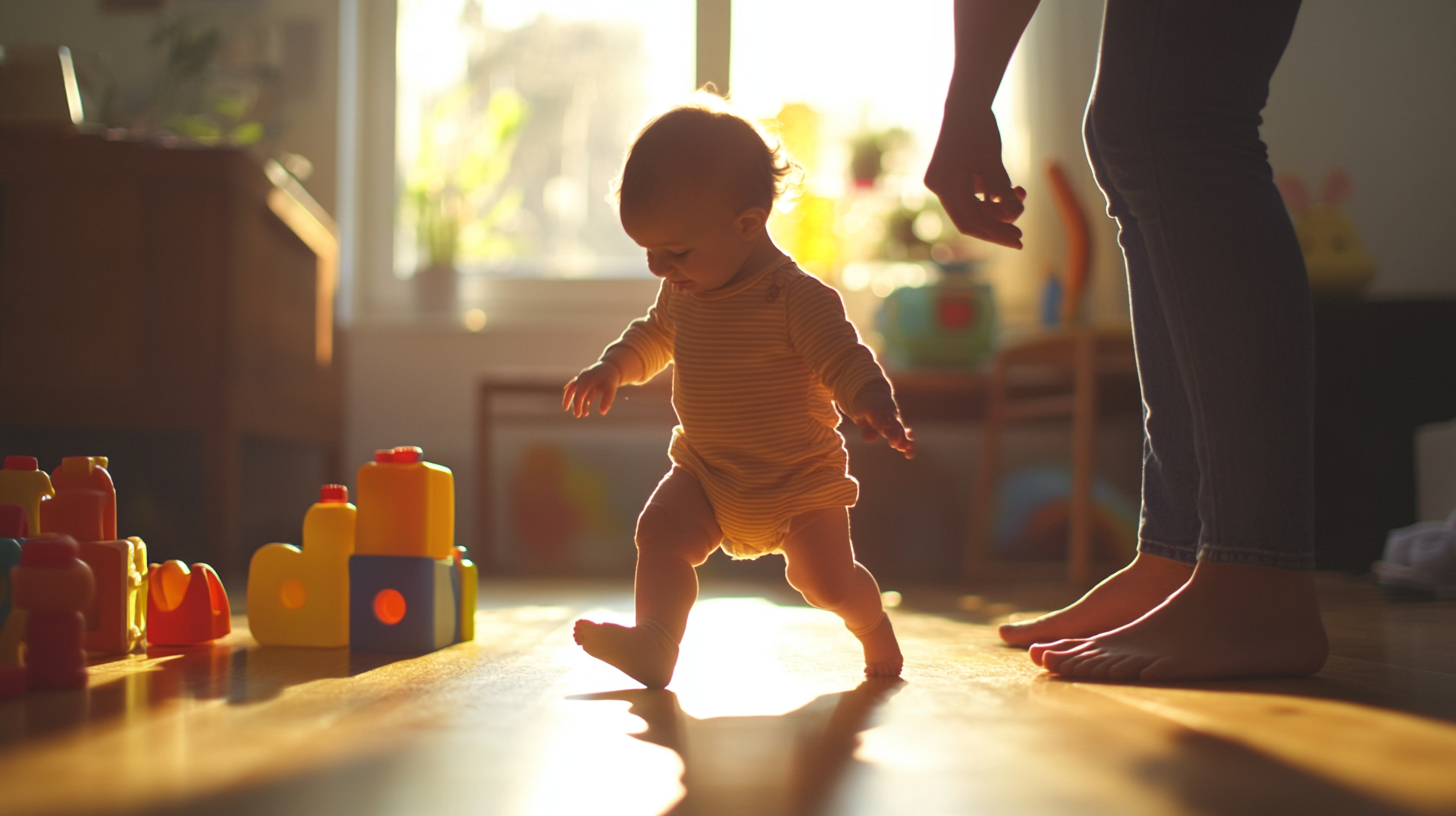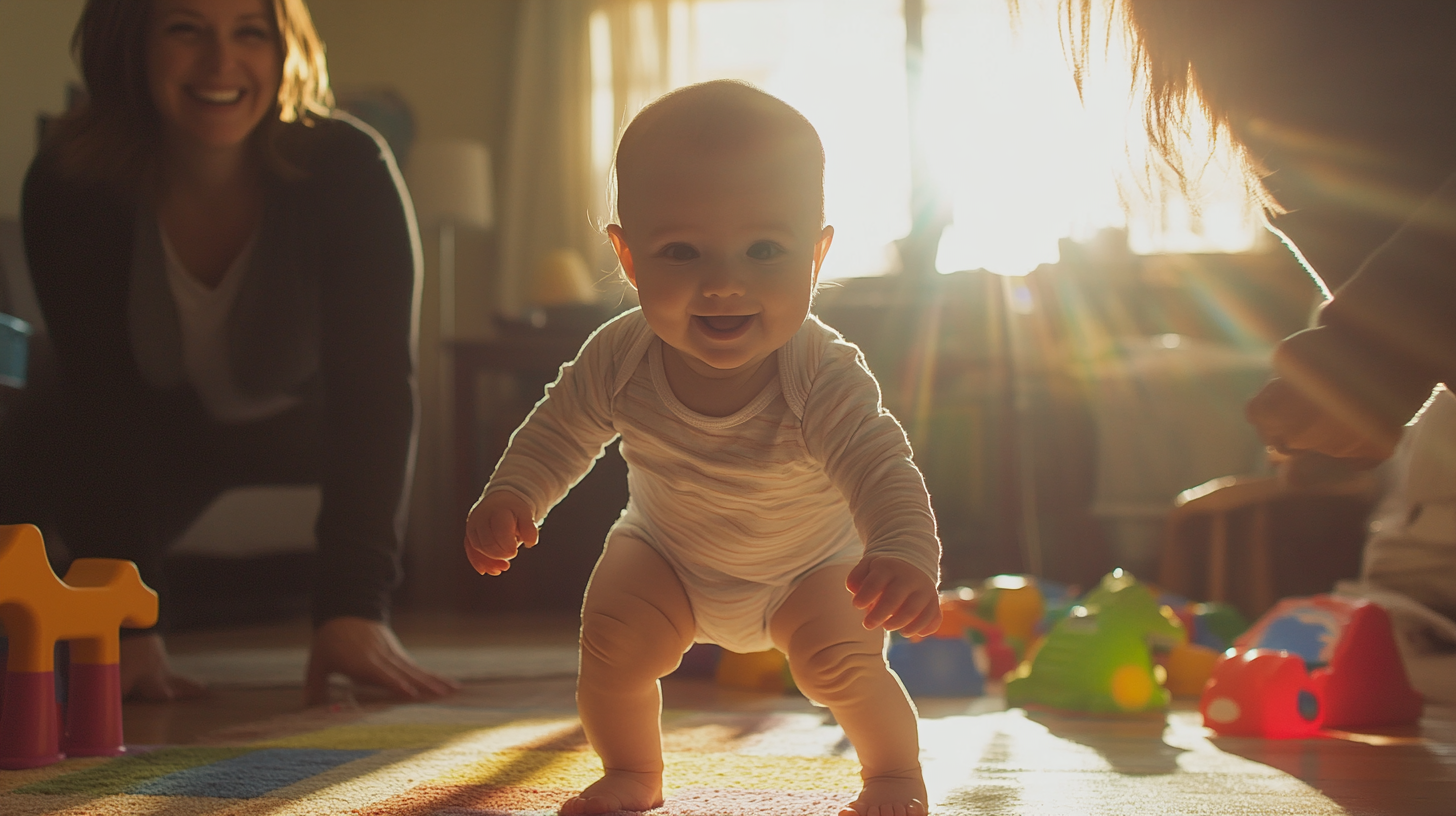What Are the Signs My Baby Is Ready to Walk?
Before embarking on the adventure of walking, babies generally achieve several important milestones. Here’s a brief timeline of what you can expect:
- Sitting Up: Around 6 months, babies gain the strength to maintain an upright position without support.
- Pulling to a Stand: Many babies pull up to a standing position around 10 months, using their developing muscles to lift their torso.
- Cruising: Babies start cruising by moving around furniture, testing their balance and coordination.
- Walking: Finally, they master the art of lifting one foot while balancing on the other—let the walking begin!
How Your Baby Learns to Walk
Every child’s journey to walking is distinct, with most taking their initial steps between 9 to 15 months. They may resemble little Frankensteins, arms outstretched, and bodies wobbling about. In this learning phase, they need to fine-tune their muscle control; it’s not just about strength but finding that delicate balance of relaxation and stability in their legs. Dr. Jody L. Jensen highlights that walking is all about mastering muscle tension—a skill they’ll soon develop as they become more confident on their feet!
How to Encourage Baby to Walk
Even if your baby seems comfortable crawling, there are several delightful ways you can encourage them to take their first steps:
- Let them cruise along sturdy furniture for balance.
- Introduce a push toy to entice movement (just steer clear of traditional baby walkers!).
- Place intriguing toys just out of reach to create a motivating challenge.
- Support them gently to build their confidence as they practice.
- Praise, praise, praise! Your encouragement will motivate their exploration!
When Do Babies Need Shoes?
Letting your baby walk barefoot is ideal; it allows their tiny feet to feel and learn the ground beneath them. However, when it’s time to step outside, look for flexible shoes with soft soles that can bend easily to support their newfound skills.
When to Call a Health Care Provider
If you’re worried because your little one isn’t walking while others are, remember that development varies among children. However, if your baby hasn’t taken their first steps by 18 months, it would be wise to consult a pediatrician for guidance.
Every baby is on their own timeline—so sit back, relax, and enjoy every incredible moment of this beautiful journey together!
When Will My Baby Start Walking?
A child’s first year of life is full of physical milestones, from rolling over to beginning to crawl, but perhaps the most anticipated goalpost might be those first steps. If you’re a new parent, you’re bound to ask yourself: When do babies start walking?
While every baby is different, most children usually take their first steps around 15 months of age, as an average, according to the American Academy of Pediatrics (AAP). However, walking isn’t just about the physical movement; it’s also about independence and a new tactic for interacting with surroundings. “Getting around on their own allows your child to interact and explore the world in a whole new way,” emphasizes Laura Jana, MD, author of Heading Home with Your Newborn. “It opens all sorts of new possibilities.” Ahead, learn more about when babies begin walking and what to expect for this particularly exciting milestone.
What Are the Signs My Baby Is Ready to Walk?
In order to start walking independently, babies need to master other developmental milestones first. Here’s a quick timeline of what you’ll likely see before your baby takes their first steps:
- Sitting Up: At around 6 months of age, your baby starts solving the puzzle of how to use the muscles in their trunk to stay upright without additional support.
- Pulling to a Stand: The timing of this varies, but many babies pull up to stand around 10 months. “Seventy percent of our body mass is from the hips on up, so the legs need a lot of strength to lift the torso,” notes Jody L. Jensen, PhD, professor of kinesiology at the University of Texas.
- Cruising: Again, age varies for cruising, but when your baby does it, they’ll make their way around the room using whatever furniture is available.
- Walking: The final piece of the walking puzzle is learning how to lift off with one foot while balancing on the other!
How Your Baby Learns to Walk
Every baby reaches the walking milestone at a different time. However, your baby will likely take their first steps between 9 and 15 months. They’ll lurch along like Frankenstein as they get used to their land legs; a wide stance and outstretched arms are characteristics of all new walkers, along with steps that might resemble a waddle.
In order to stand, your baby has to contract a lot of muscles. But to walk, they eventually need to relax their hips and knees a bit. “The challenge is figuring out how to get just the right amount of muscle tension in the legs,” Dr. Jensen says. But 1-year-olds are quick learners—it won’t take long until they loosen up and are tearing around the house.
Once they get going, the next challenge is figuring out how to stop. “We say beginning walkers ‘fall’ into their steps,” says Dr. Jensen. Each step has more force than an adult’s because newbies don’t bend their knees or use a heel-toe motion, both of which absorb some of the impact. They haven’t figured out how to break their forward momentum by stopping with one foot and bringing the trailing foot to meet it. Their way of stopping? Falling. “Usually it goes step, step, fall,” Dr. Jensen says.
How to Encourage Baby to Stand
Note that it’s not uncommon for babies to alternate between crawling and walking. If your baby sees something across the room that requires their immediate attention, they may get down on all fours. It’s like they’re thinking, “I have to get there right away; walking is going to take way too long.”
Why Do Babies Learn to Walk at Different Times?
Like every other milestone, no two children are alike. Whether your child is an early or late walker says less about their future athleticism and more about whether they’re a risk-taker or a wait-and-see type. “Some kids have an ‘I can do anything!’ mentality and want to get up and get going as soon as they discover it’s an option,” says Dr. Jana. “They don’t worry about falls.” Others don’t want to start walking until they are sure they can do so fairly well. These children may turn out to be more cautious and contemplative.
What Being an Early Crawler or Walker Could Mean for Your Baby’s Future
Aside from personality, a couple of other factors affect when babies start walking:
- Recurrent Ear Infections: “If a child is 16 months or older and isn’t walking, we ask about illnesses. An ear infection can throw off a baby’s balance and delay walking,” Dr. Jensen explains.
- Birth Order: A baby with an older sibling may be motivated to walk earlier because they want to keep up and imitate what the big kid is doing.
Ways to Encourage Your Baby to Walk
Let’s face it—some babies are just comfortable crawling and may not feel the urge to get up on their feet! However, there are things you can do to encourage your baby to practice the motions needed to walk. Here are some suggestions:
- Encourage your baby to cruise while holding onto something steady, like a sofa or couch.
- Offer them a push toy to entice them to move around. Note that a push toy is not the same as a rolling baby walker with a sit-in contraption. The AAP has called for a ban on baby walkers, as they have contributed to serious injuries in young children and are considered dangerous.
- Put toys just out of your child’s grasp so they have to reach up or down to get them.
- Support them! If your child is feeling uncertain, hold onto their trunk or hands and allow them to walk with you. Gradually reduce this support over time and see what they can do on their own.
- Praise, praise, praise. Babies and toddlers love to feel proud of themselves, so the more praise and verbal encouragement you can offer them (with a big, beaming smile), the better!
When Do Babies Need Shoes?
Babies learn to walk more easily if they don’t wear shoes, as bare feet allow direct contact with the floor. When you go on outings, of course, your baby needs some shoes. Look for a pair with flexible soles—you should be able to fold the shoe in half. Once your little one is walking outside, consider a pair with skid-resistant soles.
When to Call a Health Care Provider
What if all the other babies in the playgroup are on two feet, and yours is content with the view from the floor? As we mentioned before, all babies develop at a different rate, so this might not be a cause for concern. However, if your baby hasn’t taken their first steps by 18 months, be sure to reach out to a pediatrician or health care provider for further advice and guidance.

| Key Points | Details |
|---|---|
| Average Age for First Steps | Most babies take their first steps around 15 months old, but this can vary. |
| Developmental Milestones | Key milestones include sitting up (6 months), pulling to a stand (10 months), and cruising. |
| Walking Patterns | Babies typically exhibit wide stances, outstretched arms, and may fall as they learn to walk. |
| Factors Affecting Walking Timeline | Personality traits, recurrent ear infections, and birth order can influence when a baby begins to walk. |
| Encouraging Walking | Parents can encourage walking through cruising, using push toys, and providing praise. |
| When to Seek Help | If a child hasn’t walked by 18 months, parents should consult a pediatrician for guidance. |
| Details on First Steps | Children may walk as early as 9 months or as late as 15 months. Their walking resembles a “Frankenstein” style and involves learning to stop effectively. |
| Mastery of Muscle Control | To walk, babies need to find the right amount of muscle tension to control their movements and ensure balance. |
| Significance of Early Walking | Children who walk early may be more adventurous, while late walkers might be more cautious. Health issues and sibling dynamics also play a role. |
| Recommended Shoe Tips | For learning to walk, children should go barefoot; when outside, shoes should be flexible and fitted with skid-resistant soles. |



